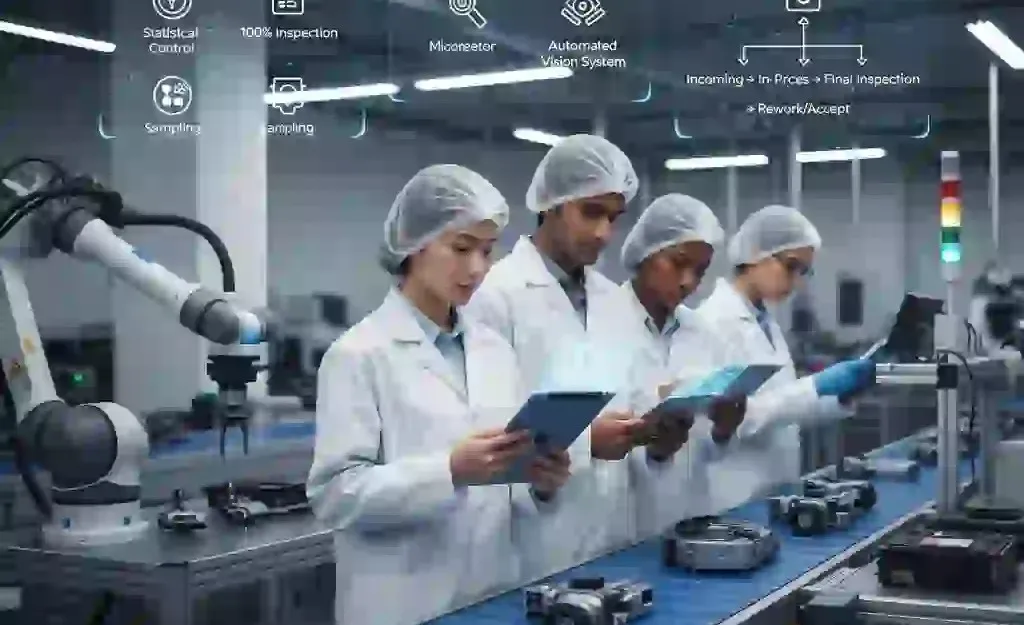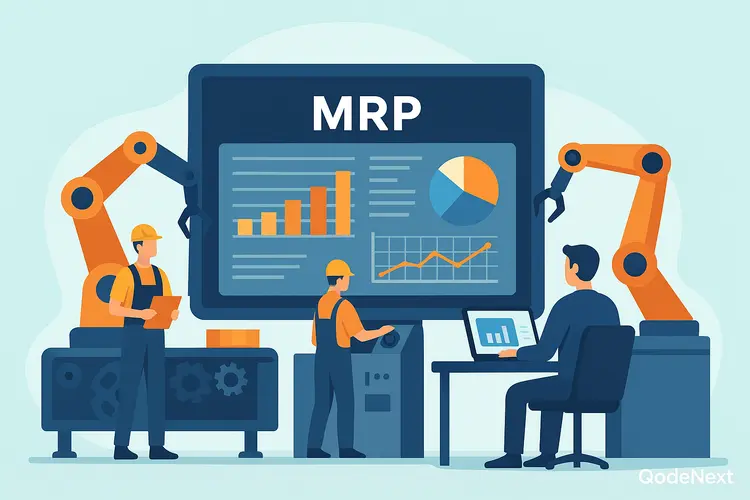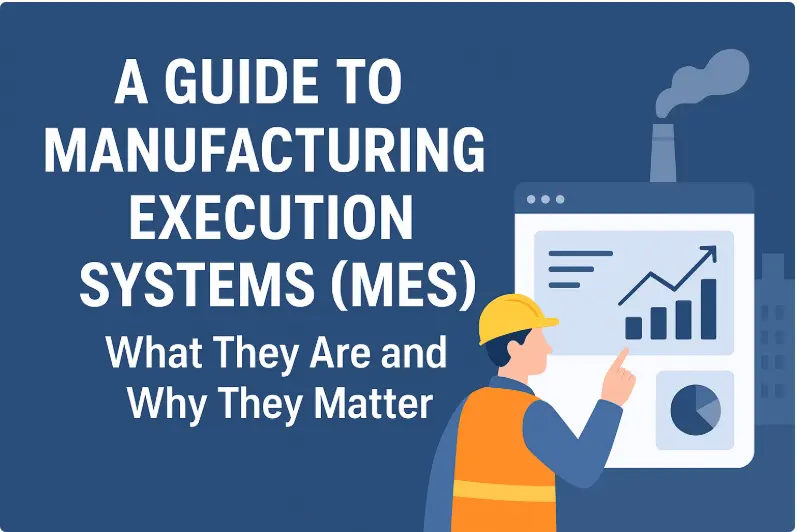Introduction: Why Quality Control is the Heart of Manufacturing
Imagine your factory produces 50,000 units a day. If 2 per cent of those are defective, that means 1,000 faulty products reach customers. The financial impact extends beyond scrap and rework. It includes returns, recalls, warranty claims, and, worst of all, loss of customer trust. This is why quality control in manufacturing is essential. Quality control ensures that every unit meets customer expectations and compliance standards. It reduces waste, improves efficiency, and builds long-term brand loyalty. Companies like Toyota, Pfizer, Samsung, and Coca-Cola demonstrate that effective quality control is not just a requirement; it is a competitive advantage.
Ready to transform your quality processes? Let’s dive in.
Why Many Factories Struggle with Quality Control
Many factories struggle with quality control because they treat it as a final checkpoint rather than an ongoing process. Relying only on end-line inspections leads to late defect detection, while overdependence on manual checks increases human error. Additionally, many manufacturers underutilise data-driven tools like Statistical Process Control (SPC), IoT, and automation, which can prevent issues in real time. This results in high rework costs, frequent customer complaints, compliance risks, and ultimately, a loss of profitability and brand trust.
Confusing QA vs QC
Many manufacturers confuse quality assurance (QA) with quality control (QC). QA is preventive and process-focused. QC is detective and product-focused. Most factories rely only on QC at the end of production. By that point, it is often too late to prevent large-scale defects.
Overreliance on Manual Inspections
Human inspectors can tire and make mistakes, especially in fast-paced industries such as PCB assembly and beverage bottling.
Lack of Data Utilisation
Factories often collect production data but do not use it. Statistical process control (SPC), IoT sensors, and AI-powered defect detection can reduce risks, but many businesses overlook these tools.
Cost of Poor Quality (COPQ)
Industry studies show that poor quality eats up 10 to 20 per cent of annual revenue. Ford recalled 1.3 million cars in 2019 due to suspension defects, costing billions. A single mislabeling issue in pharmaceuticals can lead to massive recalls and penalties. Without a structured quality control process, manufacturers quietly lose both money and reputation.
What is Quality Control in Manufacturing?
Quality control (QC) is the process of ensuring that every manufactured product meets set quality standards before reaching the customer. A simple analogy: In a bakery, QA checks that the recipe and oven settings are correct, while QC is the final taste test before selling the bread.
Difference Between QA and QC
Quality Assurance (QA) and Quality Control (QC) are often used interchangeably, but they play very different roles in manufacturing.
Quality Assurance (QA):
QA is proactive. It focuses on designing processes, systems, and standards to prevent defects before they occur. For example, creating Standard Operating Procedures (SOPs), training employees, and conducting process audits are all part of QA.
Quality Control (QC):
QC is reactive. It involves inspecting, testing, and verifying the final product to ensure it meets specifications. For example, checking finished batches of pharmaceuticals for labelling accuracy or inspecting car parts for defects before shipping.
QA vs QC: Key Differences
| Aspect | Quality Assurance (QA) | Quality Control (QC) |
| Definition | Proactive process to prevent defects by improving systems and processes. | Reactive process to detect and fix defects in the final product. |
| Focus | Process-oriented – ensures the manufacturing process is effective. | Product-oriented – ensures the output meets required standards. |
| Objective | To build quality into the process and avoid errors. | To verify the product’s quality and catch any defects. |
| Approach | Preventive | Corrective |
| Activities | Process design, SOP creation, employee training, and audits. | Product inspection, testing, sampling, and defect identification. |
| Responsibility | Management and process teams. | Quality inspectors, QC engineers, and operators. |
| Example in Manufacturing | Implementing Six Sigma to minimise variation in production. | Inspecting car engines before dispatch to detect faulty ones. |
| When Applied | Throughout the production process (before and during). | At the end of the production line (after manufacturing). |
Why Quality Control Matters
1. Ensures compliance with ISO, FDA, BIS, and other regulatory standards
In today’s global manufacturing ecosystem, compliance isn’t optional — it’s mandatory. Regulatory bodies like ISO (International Organisation for Standardisation), FDA (Food and Drug Administration), and BIS (Bureau of Indian Standards) enforce strict guidelines to ensure safety, quality, and reliability. A strong quality control system ensures every product meets these requirements consistently, helping manufacturers avoid costly penalties, product bans, or legal issues.
2. Builds customer trust and satisfaction
Customers expect defect-free, safe, and reliable products. Even a small quality slip — like mislabeled medicine or a faulty car part — can cause irreparable damage to a brand’s reputation. Quality control assures that products delivered to customers meet or exceed their expectations. This not only builds trust but also encourages repeat purchases and positive word-of-mouth, strengthening long-term customer loyalty.
3. Reduces waste, rework, and recalls
Poor quality often leads to wasted materials, costly rework, and large-scale product recalls. Each of these adds significant hidden costs to a company’s bottom line. With effective quality control — such as real-time monitoring, SPC tools, and automated inspection systems — manufacturers can detect issues early, minimise scrap, and prevent defective products from reaching customers. This reduces the overall Cost of Poor Quality (COPQ), which can account for 10–20% of revenue if left unchecked.
4. Improves operational efficiency and profitability
A factory with strong quality control doesn’t just produce better products — it runs more efficiently. Standardised processes, trained operators, and continuous monitoring lead to fewer disruptions, smoother workflows, and optimised use of resources. This boosts throughput and reduces downtime. In turn, lower defect rates and higher efficiency translate directly into higher profitability and a stronger competitive edge in global markets.
In short: Quality control isn’t just a cost centre — it’s a growth driver. It ensures compliance, keeps customers happy, reduces hidden losses, and strengthens the overall health of manufacturing operations.
Evolution of Quality Control
1940s: Manual inspections
In the early days of mass production, quality control was limited to manual inspections. Workers visually checked products at the end of the production line. While simple, this approach was reactive and often failed to catch defects early, leading to higher scrap and rework.
1970s: Statistical Process Control (SPC) and Deming’s methods
The 1970s marked a shift from inspection-based quality to process-driven quality. Dr W. Edwards Deming introduced Statistical Process Control (SPC), which used control charts and data analysis to monitor variation and prevent defects during production, not just at the end.
1980s: Total Quality Management (TQM) and Six Sigma
Manufacturers began embedding quality into their culture. TQM emphasised continuous improvement across the entire organisation, while Six Sigma introduced a structured methodology to minimise variation and achieve near-perfect quality. This era made quality a company-wide responsibility rather than just a department’s job.
2000s: Automated inspections and ERP integration
With advances in computing, industries started adopting automated inspection systems (like machine vision and X-ray scanners) to reduce human error. At the same time, ERP (Enterprise Resource Planning) systems allowed better integration of quality data with supply chain, production, and reporting.
Today: AI, IoT, and predictive analytics with Industry 4.0
In the era of Industry 4.0, quality control is smarter and predictive. Artificial Intelligence (AI) and Machine Learning (ML) can detect defects in real time, while IoT sensors track machine health and process variations continuously. Predictive analytics helps prevent failures before they occur, ensuring zero-defect manufacturing and improved efficiency.
Quality Control in Manufacturing
Quality control (QC) in manufacturing is the process of ensuring that every product meets defined standards before it reaches the customer. It involves monitoring, inspecting, and improving different stages of production to prevent defects and maintain consistency.
Key points:
- Ensures compliance with standards like ISO, FDA, and BIS.
- Builds customer trust and satisfaction through reliable products.
- Reduces waste, rework, and costly recalls.
- Improves operational efficiency and profitability.
- Methods include manual inspection, SPC, TQM, Six Sigma, and automation.
- Modern QC uses AI, IoT, and predictive analytics as part of Industry 4.0.
In short, quality control is not just about catching defects at the end — it’s about creating a system that drives efficiency, compliance, and long-term success in manufacturing.
Step-by-Step Quality Control Process
1. Define quality standards (ISO, BIS, FDA, or customer-specific)
The first step is to establish clear benchmarks for quality. These may include international standards like ISO 9001, regulatory requirements such as FDA guidelines for pharmaceuticals, BIS standards for Indian markets, or even specific customer requirements. Defining standards ensures everyone in the organisation understands what “quality” means for the product being manufactured.
2. Identify critical control points (CCPs)
Not every stage of production carries the same risk of defects. Manufacturers must identify critical control points — the areas where mistakes are most likely to occur. For example, sealing caps in beverage bottling, soldering points in electronics, or labelling in pharmaceuticals. Monitoring these key points helps detect defects early before they move downstream.
3. Select the right QC methods (manual, SPC, or automated)
Depending on the industry, complexity, and risk, manufacturers must choose suitable QC methods:
- Manual inspections for simple, low-risk checks.
- Statistical Process Control (SPC) for tracking variation in critical processes.
- Automated QC using machine vision, sensors, or X-ray systems for real-time, high-precision defect detection.
Choosing the right method ensures cost-effectiveness and accuracy.
4. Document Standard Operating Procedures (SOPs)
Well-documented SOPs provide step-by-step guidance on how quality checks should be carried out. They ensure consistency across shifts, plants, and teams. SOPs act as a training tool for new employees and help maintain compliance with ISO and regulatory audits.
5. Train employees to detect and report issues
Employees are the first line of defence in quality control. Proper training empowers operators to recognise early warning signs of defects, halt production when necessary, and escalate issues quickly. A culture of quality ensures employees feel responsible and motivated to uphold standards.
6. Monitor key performance indicators (KPIs)
Manufacturers need to track measurable metrics such as:
- Defects per million opportunities (DPMO)
- First pass yield (FPY)
- Rework rates
- Customer complaints and returns
By continuously monitoring KPIs, companies can identify trends, predict problems, and evaluate the effectiveness of QC programs.
7. Apply Corrective and Preventive Actions (CAPA)
Even the best systems encounter issues. When a defect or non-compliance occurs, a structured CAPA process ensures the root cause is identified and fixed. Corrective actions address the immediate issue, while preventive actions ensure it doesn’t happen again. CAPA closes the loop, driving continuous improvement in manufacturing quality.
Note: Companies like Qodenext help digitise QC by offering RFID, MES, and automation solutions that ensure traceability and compliance.
Quality Control Tools and Techniques
Basic Seven QC Tools
The Seven Basic Quality Control (QC) Tools are simple yet powerful techniques used across industries to detect, analyse, and solve quality problems.
1. Pareto Charts
A Pareto chart highlights the most common causes of defects using the 80/20 rule — showing that 80% of problems usually come from 20% of causes. This helps manufacturers focus on the most critical issues first.
2. Fishbone Diagrams (Ishikawa or Cause-and-Effect Diagrams)
Fishbone diagrams visually map out potential causes of a defect, such as manpower, machinery, materials, or methods. They are excellent for root cause analysis in complex manufacturing environments.
3. Control Charts
Control charts monitor process variations over time using upper and lower control limits. They help identify whether a process is stable or if corrective action is needed.
4. Histograms
Histograms show the frequency distribution of data, making it easy to identify trends, patterns, and variations in product quality.
5. Check Sheets
Check sheets are structured forms used to collect real-time data, such as defect types or frequency. They simplify data-driven decision-making on the shop floor.
6. Scatter Diagrams
Scatter diagrams show the relationship between two variables (e.g., temperature vs. defect rate). They help detect correlations that might affect product quality.
7. Flowcharts
Flowcharts map out the steps in a process, helping identify bottlenecks, inefficiencies, or areas prone to errors.
Advanced Tools for Modern Quality Control
With Industry 4.0, quality control has moved beyond manual tools to advanced, technology-driven solutions.
1. IoT Sensors for Machine Health Monitoring
IoT devices track machine conditions like vibration, temperature, and pressure in real-time. This enables predictive maintenance and reduces the chances of machine-related defects.
2. AI-Based Defect Detection
Companies like Bosch and Siemens use AI-powered vision systems to detect microscopic defects that humans might miss. These systems ensure faster inspections and near-zero error rates.
3. Digital Twins for Simulation
A digital twin is a virtual replica of a production process or machine. Companies like GE Aviation use it to simulate production scenarios, predict failures, and improve efficiency before real-world issues occur.
4. Manufacturing Execution Systems (MES)
MES platforms, such as those offered by Qodenext, provide real-time tracking of quality, production, and compliance. They integrate shop-floor data with enterprise systems for faster decision-making.
5. Roles and Responsibilities in Quality Control
Effective QC is a team effort that involves multiple roles working together.
6. Operators
Operators are the first line of defence. They detect issues at the source and stop production if necessary to prevent defective products from moving downstream.
7. Supervisors
Supervisors ensure that standard processes and SOPs are followed consistently across shifts. They also provide guidance and escalate issues when needed.
8. Quality Engineers
Quality engineers are responsible for root cause analysis, advanced defect detection, and implementing corrective and preventive actions (CAPA).
9. Management
Management plays a critical role by building a culture of quality within the organisation. They allocate resources, enforce quality policies, and ensure continuous improvement.
10. Best Practices for Quality Control
To achieve world-class manufacturing quality, businesses should adopt these best practices:
11.Build a Culture of “Quality at Source”
Quality should not be limited to inspections at the end of the line. Instead, every employee must take ownership of product quality at their stage of work.
12. Conduct Layered Audits Regularly
Regular audits at multiple levels — from operators to senior managers — help identify gaps and maintain accountability across the organisation.
13. Use Real-Time Dashboards for Defect Alerts
Real-time dashboards and QC software allow immediate visibility into production issues, enabling faster corrective action.
14. Integrate Customer Feedback
Customer complaints and reviews should be fed back into quality processes. This ensures that improvements are not only internal but also aligned with market expectations.
Common Mistakes to Avoid in Quality Control
Despite good intentions, many factories make mistakes that weaken their QC systems.
1. Relying Only on End-Line Inspection
Detecting defects only at the end of production is reactive and costly. By then, materials, time, and effort have already been wasted.
2. Neglecting Employee Training
Without proper training, employees may miss defects or fail to follow SOPs correctly. Continuous training ensures awareness and accountability.
3. Failing to Track the Cost of Poor Quality (COPQ)
Not measuring COPQ hides the true financial impact of defects, rework, and recalls. Tracking this helps justify investments in better QC systems.
4. Avoiding Investment in Digital QC Tools
Factories that avoid automation, AI, or IoT for cost reasons often face higher losses in the long run due to inefficiencies and recurring defects.
Case Studies: Examples of Quality Control in Manufacturing
1. Toyota (Automotive) – Using SPC and Kaizen to Minimise Recalls
Toyota is a global leader in quality management, largely due to its commitment to Statistical Process Control (SPC) and the Kaizen philosophy of continuous improvement.
Challenge: In the early 2000s, Toyota faced several recalls due to production scaling.
Solution: The company strengthened SPC to monitor process variations in real time and implemented Kaizen workshops across all plants. Workers at every level were empowered to stop production if they noticed potential defects.
Impact: These initiatives reduced recalls by 30 per cent and strengthened Toyota’s reputation as a benchmark in automotive quality.
2. Pfizer (Pharmaceuticals) – Automated QC for Compliance and Safety
Pfizer, one of the world’s largest pharmaceutical companies, operates under strict regulatory frameworks such as the FDA and EMA. Ensuring packaging accuracy and drug authenticity is critical.
Challenge: Manual packaging inspections could not keep up with global demand and posed risks of mislabeling.
Solution: Pfizer implemented automated QC systems with vision technology to detect errors in labelling, barcodes, and seals at high speeds.
Impact: Packaging accuracy rose significantly, ensuring compliance with global regulations and protecting patient safety.
3. Qodenext – Driving Digital Transformation in QC Across Industries
While major companies have heavily invested in advanced QC, many medium and large manufacturers still grapple with manual checks, a lack of traceability, and high defect rates. This is where Qodenext offers a vital solution.
Solution Offering: Qodenext integrates RFID, MES (Manufacturing Execution Systems), and automation solutions to digitise quality tracking, traceability, and compliance.
Use Cases:
In automotive, RFID tags track parts from the supplier to the assembly line, reducing mix-ups.
In pharmaceuticals, MES ensures packaging accuracy and traceability for compliance.
Impact: By digitising QC, Qodenext assists manufacturers in achieving real-time defect tracking, compliance assurance, and efficiency gains, bringing top-tier standards within reach for industries in India and beyond.
Future of Quality Control with Industry 4.0
1. Artificial Intelligence (AI) and Machine Learning for Predictive Defect Detection
AI-powered quality control systems use machine learning algorithms to analyse real-time production data, images, and sensor readings. Unlike traditional QC, which finds defects after they happen, AI predicts potential failures before they occur.
Example: In automotive manufacturing, AI vision systems can spot micro-cracks in metal parts that human inspectors might miss.
Benefit: Reduces recalls, prevents downtime, and maintains consistent product quality.
2. IoT-Enabled Live Monitoring of Machines and Processes
The Internet of Things (IoT) connects machines, tools, and products through sensors that continuously collect and transmit data. In quality control, IoT tracks every process variable—temperature, pressure, speed, vibration—in real time.
Example: In the food industry, IoT sensors monitor cold chain logistics to ensure products are stored at safe temperatures.
Benefit: Instant alerts help prevent quality failures and minimise waste.
3. Blockchain for Supply Chain Traceability and Transparency
Blockchain offers tamper-proof data recording for manufacturing quality control. Every stage of production, from raw material sourcing to final delivery, can be logged in a transparent ledger.
Example: In pharmaceuticals, blockchain helps prevent counterfeit drugs from entering the supply chain, validating every transaction.
Benefit: Builds trust with regulators and customers by proving product authenticity and compliance.
4. Digital Twins for Error Simulation and Prevention
A digital twin is a virtual replica of a physical product, machine, or process. Manufacturers can test different scenarios on the twin before applying changes to the actual system.
Example: In aerospace, companies like GE Aviation use digital twins of engines to predict part failures and schedule maintenance ahead of time.
Benefit: Prevents costly breakdowns, cuts downtime, and improves product reliability.
5. AR/VR-Based Quality Control Training Modules for Employees
Augmented Reality (AR) and Virtual Reality (VR) are changing employee training. Instead of reading manuals, workers can train in immersive, hands-on simulations.
Example: An AR headset can guide an operator step-by-step during an inspection process, highlighting potential defects directly on the product.
Benefit: Faster learning, fewer mistakes, and more consistent inspections.
6. Green Quality Control with a Focus on Sustainability
Future quality control will not only emphasise defects but also environmental impact. Sustainable QC ensures that waste, energy usage, and emissions are tracked as part of product quality.
Example: In electronics, manufacturers are designing QC systems to measure the recyclability of materials used in devices.
Benefit: Aligns with global sustainability goals, reduces carbon footprint, and appeals to eco-conscious customers.
Conclusion
Quality control in manufacturing is not a cost burden but a driver of growth. By embedding QC at every step, companies can reduce waste, build customer trust, and maintain compliance. In the age of Industry 4.0, manufacturers who adopt digital quality control will stay ahead of the competition. To achieve world-class quality standards, manufacturers can utilise solutions such as RFID, MES, and automation. Explore how Qodenext helps manufacturers integrate these technologies to boost efficiency and compliance.
FAQs on Quality Control in Manufacturing
1. Why is quality control important in manufacturing?
It helps reduce defects, ensures compliance, and improves profitability.
2. How can quality control be implemented effectively?
By setting standards, training employees, monitoring KPIs, and using continuous improvement methods.
3. What are examples of quality control in manufacturing?
Toyota in automotive, Pfizer in pharma, Samsung in electronics, and Coca-Cola in beverages.
4. How can SMEs implement QC on a budget?
By using basic QC tools and affordable digital solutions such as Qodenext MES and RFID.
5. What is blockchain, and are the latest technologies in QC?
IoT advanced automated inspection systems.
6. Who is responsible for quality control?
Everyone in the organisation, from operators to top management.
7. How to implement quality control in manufacturing?
Quality control in manufacturing can be implemented by following a structured process:
- Define product and process standards (ISO, FDA, BIS, or customer-specific).
- Identify critical control points where defects are most likely to occur.
- Select the right QC methods, such as manual checks, SPC (Statistical Process Control), or automated inspections.
- Document SOPs to ensure uniformity across shifts.
- Train employees to act as the first line of defence against defects.
- Track KPIs like defect rates and rework costs.
- Use CAPA (Corrective and Preventive Actions) for continuous improvement.
Example: A textile factory uses RFID-based batch tracking to detect defective rolls early, reducing customer complaints and wastage.
Q8. Why is quality control important in manufacturing?
Quality control is vital because it ensures consistency, safety, and efficiency in production.
- It builds customer trust by delivering defect-free products.
- Prevents costly recalls, warranty claims, and compliance issues.
- Saves up to 20% of annual revenue typically lost to poor quality.
- Improves efficiency by minimising rework and downtime.
- Creates a competitive advantage in global markets.
Example: Coca-Cola inspects every bottle using machine vision to prevent contamination and maintain brand trust.
Q9. How to control quality in manufacturing?
Manufacturers can control quality by embedding QC into processes rather than leaving it only at the end:
- Train operators to detect and stop defects at source.
- Use IoT and MES for real-time monitoring of machines and processes.
- Apply SPC tools like control charts to track process variations.
- Conduct layered audits to ensure compliance.
- Integrate customer feedback into quality improvement.
Example: Pfizer uses automated inspection systems to ensure labelling accuracy in pharmaceuticals, preventing compliance issues.
Q10. What are some quality control examples in manufacturing?
Quality control varies by industry:
- Toyota (Automotive): Uses Kaizen and SPC to reduce recalls.
- Pfizer (Pharmaceuticals): Relies on automated QC for packaging accuracy.
- Coca-Cola (Food & Beverage): Uses machine vision for bottle inspection.
- Samsung (Electronics): Employs Automated Optical Inspection (AOI) for PCB defect detection.
- Adidas (Textiles): Implements RFID-based QC for faster defect detection and batch rejection.







